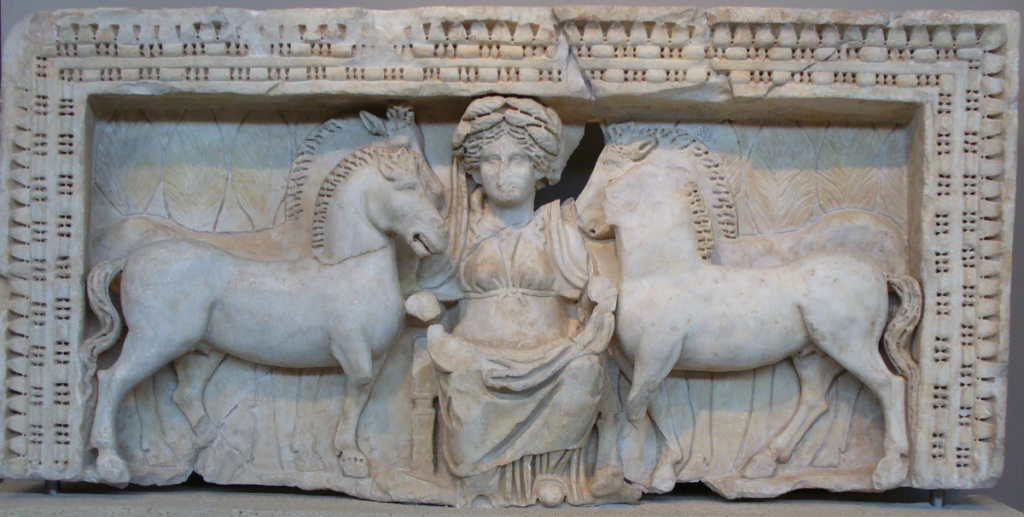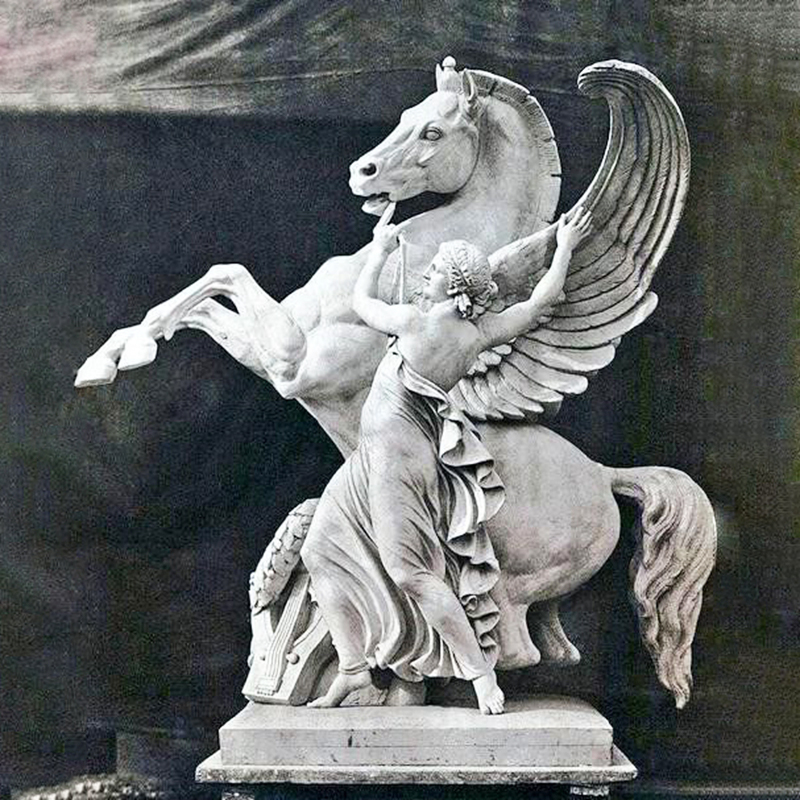Well, this one is new to me.
And I always love, love, love it when I find out something new about Isis.
I found this ‘something new’ in an article about connections between Isis and the Celtic Horse Goddess Epona in Apuleius’ ancient tale known as The Golden Ass. (This is the one that has a fictionalized account of initiation into the Mysteries of Isis in the Greco-Roman world.) And I thought I’d share some of these possibilities with you.
Now I’m going to say right up front, I think the connections are fairly tenuous. Nonetheless, a professor of Classics (Jeffrey Winkle) wrote a whole article about it, so for me, it’s decidedly interesting enough to look into. What I think it boils down to is that many of the soldiers in the Roman Cavalry had a devotion to Isis—particularly as Isis-Fortuna and Isis the Savior because they were soldiers—and to the Goddess Epona—because they were in the cavalry and horses were vital to them. Very often, as we may experience in our own devotions, Deities can come together in our minds and hearts as we worship Them.
Now, a note for those of you who have a devotion to Epona. I don’t know much about Her—and certainly not on an experiential level as you know Her—but I do understand that She is more than “just a horse Goddess.” All Deities are more than Their short-form definitions. More broadly, Epona the Great Mare, is a Goddess of Abundance and Her images often include cornucopias, sheaves of grain, along with newborn foals. Thus, like Isis, a couple other short-form definitions for Epona are Goddess of Fertility and Mother Goddess (She is often shown with the Matres).
There is another fertility and motherly Goddess Who is a great mare: Demeter. One tale says that as Demeter is searching for Her daughter, Poseidon (short-form: Sea God, Earthquake God, and Horse God) becomes sexually obsessed with Her. She turns Herself into a great mare in an attempt to hide from Him, but He transforms into a great stallion and succeeds in raping the Goddess in this form. As a consequence, Demeter (now with the epithet Erinyes, “Fury”) gives birth to Areion, an immortal and heroic horse. Pausanias tells us of a sacred image of Demeter in Arcadia made with the head and hair of a horse. We already know how closely connected Isis and Demeter came to be in the Hellenic world; parts of Their myths become indistinguishable. An important Egyptian Goddess later syncretized with Isis, Hathor, is specifically called Mistress of Horses at Her temple at Denderah.
In addition to being Fertility and Mother Goddesses, Epona and Isis (as well as Hathor and Demeter for that matter) also share an underworld connection. Epona sometimes carries a Hekate-like key to the underworld and She and Her horses can serve as psychopomps leading the souls of the dead into the afterlife. If you’ve been reading this blog, I certainly don’t have to tell you about Isis’ care for, protection of, and guiding of the dead.
So, the slim threads of connection are there. Still, we don’t find images of Isis with a horse’s head, or in the form of a horse, or even riding a horse as we do Epona. The horse does make an appearance in Plutarch’s telling of the Isis and Osiris tale. When asked by Osiris which animal He thinks is the most useful for a soldier, Isis’ son Horus names the horse. And we do find late images of Horus, particularly as Harpokrates, riding on a horse. Isis Herself can also be broadly connected with the ass since it is one of the forms of Isis’ sibling Set. And hey, there is a modern racehorse named Isis, so there’s that.
Isis is further connected with the ass in Apuleius’ tale. And this is where the article I’m reading comes in. If you’re familiar with the story, you’ll know that the protagonist, Lucius, is accidentally turned into an ass by irresponsibly playing around with magic. Most of the story is about Lucius’ trials and tribulations as an ass. The denouement of the story is in its last book (we’d call it a chapter) when Lucius prays to the Moon Goddess for help and is answered by Queen Isis, Who is All Goddesses. She saves him from his asinine state, returning him to human form. He becomes initiated in Her Mysteries and is devoted to Her for the rest of his life.
It’s in all the books leading up to Lucius’ salvation by Isis that our professor looks for connections between Epona and Isis. Since Epona is protectress not only of horses, but of ponies (a small horse, not a young horse), mules (crossbreed of a horse and a donkey), donkeys (a domestic ass), and asses (a wild donkey), the ass-formed Lucius would easily come under Her purview. So what hints of Isis can we find in these other books?
In the very first line of the story, Lucius invites the reader to enjoy the tale as long as they “don’t object to reading Egyptian papyri, inscribed by a sly reed from the Nile.” As you might guess, this leads some researchers to scent a foreshadowing of Isis from the very start. Others have seen hints in the names of the Thessalian witches in one of the episodes in the story. They are Meroe and Panthia. Meroe is a Nubian city in which Isis was prominent and Panthia is close to Panthea, All Divine or All Goddess, a common epithet of Isis. But if they are supposed to hint at Isis, it must be as Her opposites, for the witches here are not the good guys.
Yet another researcher sees a prefiguration of Isis in the decorations of Lucius’ aunt’s home. The home’s atrium includes a statue of “a palm-bearing goddess, wings outspread” in each corner. Isis is indeed both winged and associated with the palm. Furthermore, we get Egyptian characters throughout the tale. In yet another episode, an Egyptian priest successfully raises a dead man to enable him to identify his murderer.
We first meet Epona once Lucius has been magically turned into an ass. Her sacred image is in the stable where Lucius spends the night awaiting the roses that will restore his humanity. Then he notices that Epona’s image is adorned with garlands of roses—exactly what he needs. Just as he is trying to reach them, a stable hand comes in and stops the uppity ass from toppling Epona’s image. A moment later, robbers break into the stable, steal the animals…and so Lucius’ adventures as an ass begin.

Here we do have a parallel between Epona and Isis. Both Goddesses offer salvation with the aid of magically needful roses, which can be associated with both of Them. Lucius is foiled before he can eat the roses of restoration that adorn the image of Epona. It is only after many trials that Lucius finds Isis and She succeeds in providing the roses that enable him to become human once more. But should we take this as an equation of Epona and Isis? I don’t think so; yet we can know that Goddesses or THE Goddess is the means to Lucius’ salvation. The article aptly describes Lucius’ meeting with the two Goddesses as “bookending” his experiences. Lucius finds Epona just after he is transformed into an ass and he finds Isis before he can become human once more.
We do have an ancient text that specifically connects Isis and Epona—and with asses. It is from an early Christian making fun of the Pagan religions, so the remark is offensive. But the point isn’t the snark; it’s that he mentions both Goddesses in the same breath and connects both with asses. Here’s the quote:
Who is so stupid as to worship this kind of thing? Who is even more stupid so as to believe such a thing is worshiped? Unless, of course, you consecrate and decorate all the asses in your stables along with your—or rather their own—Epona and you reverently do the same to all your asses with Isis.
Minucius Felix, in Octavius
From Pompeii, we have a couple of frescos linking Isis and Epona. One of them (shown above), from a stable, shows a female figure riding a horse or donkey between two lares, household guardian spirits. Some scholars think the figure between them is Isis-Epona. Another, now lost except for a drawing of the original, shows Isis Fortuna on one side of the fresco with a horse-riding Goddess, most likely Epona , on the other. This particular image comes from a bakery, where donkeys would have been used to turn the flour mill. So here we have both Goddesses and an ass once again.
So there you have it. I’m not quite convinced that there ever was a syncretic Isis-Epona, but we can say that these two foreign-to-Rome Goddesses met up in a few places and certainly share in the sisterhood of Goddesses.













